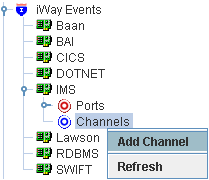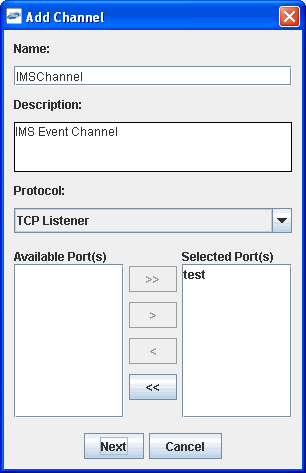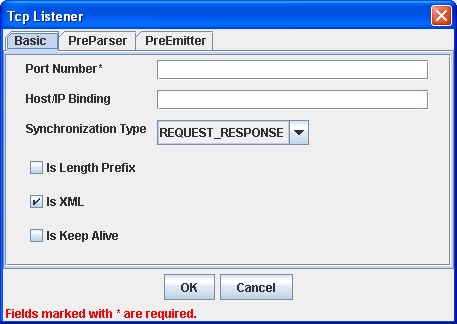Creating and Modifying a Channel
|
How to: |
A channel is created to listen for the IMS Event and process the event document. A channel that is configured using the REQUEST or REQUEST_ACK (Acknowledgment) synchronization type does not return data to the IMS application, and may be associated with one or more ports. Specifying multiple ports means that the document will be written to each port. A channel that uses the REQUEST_RESPONSE synchronization type may only be associated with a single port. If the channel converts Copybook formatted request messages to XML, a PreParser must be configured. If the channel converts XML to Copybook formatted response messages, then a PreEmitter must be configured.
When using a REQUEST/RESPONSE configuration, input and output data must be either both Copybook or XML formatted.
Procedure: How to Create a Channel
To create a channel:
- In the left pane of iWay Explorer, expand the iWay Events node.
- Expand the IMS node.
- Select the Channels node.
The following image shows the Channels node highlighted in the left pane.

- Right-click the Channels node and select Add
Channel.
The Add Channel dialog box opens.

- In the Name field, type a descriptive name for the channel, for example, IMSChannel.
- In the Description field (optional), type a brief description for the channel, for example, IMS Event Channel.
- From the Protocol drop-down list, select a channel type. TCP Listener is the only type supported by the IMS adapter.
- Select from the available ports the ones you want to associate with the channel.
- Click Next.
The TCP Listener dialog box opens where you provide parameters to specify values for the protocol you will use with the channel, as shown in the following image.

- Specify the values for the protocol you are using with the channel.
The following table lists and describes the properties in the Basic tab.
Property
Description
Port Number
Port number where your IMS connection node listens for Events generated by IMS.
Host/IP Binding
Name or IP address of the host computer where the IMS application region is running.
Synchronization Type
Choose one of the following:
- If the Event application expects a reply sent back to it, select REQUEST_RESPONSE.
- If the Event application expects a TCP/IP acknowledgment (ACK), select REQUEST_ACK.
- If the Event application does not expect a reply, select REQUEST.
Is Length Prefix
For IMS events that return data, which is not in XML format. The TCP/IP event application must prefix the data with a 4-byte binary length field when writing data to the TCP/IP port.
Is XML
For IMS events that return data in XML format. No preparser is required.
Is Keep Alive
Maintains continuous communication between the Event transaction and the channel.

The following table lists and describes the properties in the PreParser tab.
Property
Description
Location of COBOL Data Description
Path to the COBOL description of the layout sent by IMS.
For more information, see Sample Requests, Schemas, and COBOL File Descriptions.
Remote Codepage
Select the code page from the drop-down menu. Cp500 is the default value.
Use data structure information from COBOL
When this parameter is selected, the Event creates request and response documents including COBOL group levels (for example, 05, 10, 20, and others).
You must select this parameter when COBOL input or output descriptions contain the COBOL OCCURS or REDEFINES statement.
Accept multiple records in COMMAREA
When this parameter is selected, multiple COMMAREA records are read by the PreParser. Otherwise, any data in excess of the COBOL definition is truncated.
The following table lists and describes the properties in the PreEmitter tab.
Note: Specify a PreEmitter only when using the REQUEST_RESPONSE synchronization type.
Property
Description
Location of COBOL Data Description
Path to the COBOL description of the layout returned to IMS.
Remote Codepage
Select the code page from the drop-down menu. Cp500 is the default value.
Use data structure information from COBOL
When this parameter is selected, the Event creates request and response documents including COBOL group levels (for example, 05, 10, 20, and others).
You must select this parameter when COBOL input or output descriptions contain the COBOL OCCURS or REDEFINES statement.
- Click OK.
The following image shows the newly created IMSChannel under the Channels node in the left pane.

An X over the icon indicates that the channel is currently disconnected. You must start the channel to activate your Event configuration.
Procedure: How to Edit a Channel
To edit a channel:
- In the left pane of iWay Explorer, select the iWay Events tab.
- Expand the IMS node.
- Select the Channels node.
- Select the channel you want to edit.
- Right-click the channel and select Edit.
The Edit Channel dialog box opens.
- Make any required changes to the channel configuration.
Procedure: How to Delete a Channel
To delete a channel:
- In the left pane of iWay Explorer, select the iWay Events tab.
- Expand the IMS node.
- Select the Channels node.
- Select the channel you want to delete.
- Right-click the channel and select Delete.
The channel disappears from the list in the left pane.